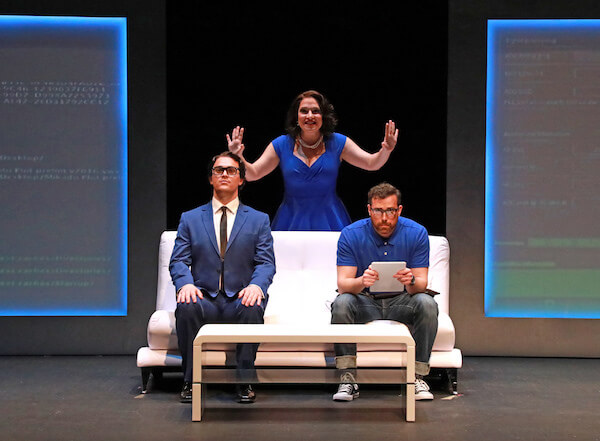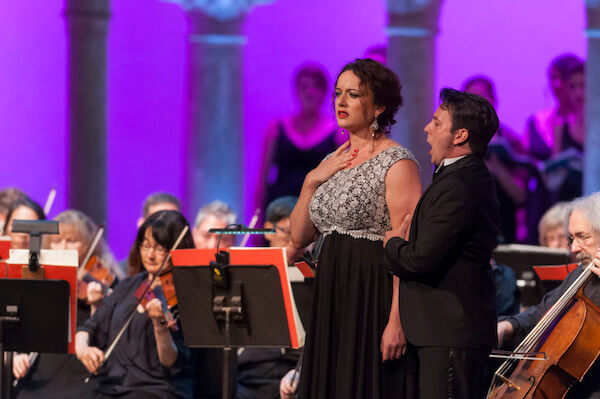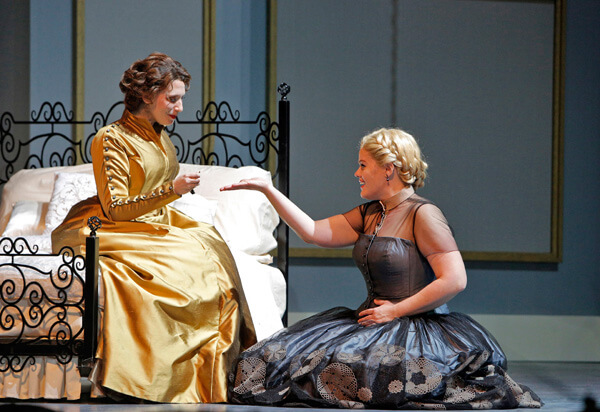Georgia Jarman and Tamara Mumford in Will Crutchfield’s production of Rossini’s “Aureliano in Palmira” at Caramoor. | GABE PALACIO
One of the ironies of music — and art in general — is that today’s popular sensation may be tomorrow’s historical footnote in an academic journal. This summer several operatic dead letters reemerged from two centuries of oblivion, shook off the dust and strutted their stuff.
Will Crutchfield led Gioachino Rossini’s opera seria “Aureliano in Palmira” at the summer 2014 Rossini Opera Festival in Pesaro in his own critical edition (the autograph of Rossini’s opera has been lost). That production won the International Opera Award in 2015 for a rediscovered work. Crutchfield scheduled “Aureliano” for its US premiere at this summer’s Caramoor Festival with an all new cast of youthful American singers.
“Aureliano” had all the earmarks of sure success when it premiered at La Scala in 1813. The 22-year-old Rossini was white hot coming off of the twin megahits “Tancredi” and “L’Italiana in Algeri” in Venice. The libretto was by Felice Romani, and the cast was headed by the last great castrato, Giambattista Velluti. Unfortunately, the tenor singing the Emperor Aurelian came down with smallpox shortly before the premiere and a mediocre substitute had to be found, necessitating unfortunate cuts and simplification of his music. Though the opera played out its run in Milan, it was considered a lesser work and seldom revived.
At Caramoor, US premiere of Will Crutchfield’s critical reading of early Rossini opera
Rossini recycled the score into several new works, including “Il Barbiere di Siviglia,” which reused the “Aureliano” overture in its entirety along with a chorus, a trio, and the cabaletta to Arsace’s Act II scena, which became Rosina’s pert “Io son docile” from her entrance aria, “Una Voce Poco Fa.”
The Caramoor concert revealed that the score of “Aureliano” is a dazzling jewel box of bel canto beauties — many familiar in different settings. Crutchfield’s research restored a crucial Act I duet between Aureliano and Arsace that was cut from the La Scala premiere.
Romani’s libretto works on two levels — the first as an 18th century Metastasio-type baroque opera seria plot concerning an enlightened ruler showing clemency to his vanquished foes. Queen Zenobia of Palmyra (modern day Syria) and her general Arsace have been defeated by the Roman Army of Emperor Aurelian but refuse to submit to imperial authority or betray each other and their country. The second level is a psychological study of the price of defeat in a Europe that saw nation after nation conquered by Napoleon — including Italy at the time the opera premiered. The audience’s sympathies are directed to the defeated royal lovers — the indomitable Queen Zenobia and her devoted and loving protector Arsace, who vow to die together rather than live in slavery. The classical subject thus comments on contemporary events in Italy and abroad.
Crutchfield’s youthful cast featured lighter voices that lacked heroic grandeur but communicated the musical beauties of the opera. Mezzo-soprano Tamara Mumford, familiar from secondary roles at the Metropolitan Opera, took the starring role of Arsace — the role created by the legendary Velluti. Mumford lacks the bravura coloratura technique or contralto thrust of a PodleÅ› or Horne. She did not ornament the music as freely as Velluti could and did. (Crutchfield has found published anthologies of Velluti’s arias which preserve Velluti’s own ornaments. According to Stendhal, they were so extensive that Rossini didn’t recognize his own music and began to write out ornamentation for his singers. Crutchfield’s research revealed that Rossini actually co-opted Velluti’s ornaments, writing them into Rosina’s “Io sono docile,” when he reused Arsace’s cabaletta in the “Barber.”) Mumford is an expressive, musical singer with an affecting dark alto-colored timbre that is inherently noble and tragic. Her scale is even over a wide range, and her phrasing emphasized restraint and classical proportion. I would love to hear her as Gluck’s Orfeo. Mumford got a star reception from the audience.
Georgia Jarman’s brightly generic coloratura soprano initially seemed too soubrettish for such a resolute and brave queen as Zenobia. The slender blonde soprano displayed bold attack and secure florid technique, bending coloratura display toward dramatic expression; precise staccato technique suggested defiance or rage, roulades expressed regal grace. The ecstatic florid duets between Zenobia and Arsace were the evening’s highlights.
Young tenor Andrew Owens made a strong initial impression as Aureliano, with bold declamation and vigorous tone. As the performance progressed he lost his vocal poise, pushing too much in the middle register and tiring in the middle of the second act. Perhaps Owens would have fared better if he had been able to sing the florid higher music composed for the originally scheduled La Scala Aureliano (lost with the autograph), including interpolated high notes and runs. Owens needs to stress head voice, higher placement, and lightness in his vocal production. Chrystal E. Williams sang the dramatically extraneous role of Publia with dignified presence and a fiercely communicative if occasionally unsteady lyric mezzo.
Crutchfield’s conducting brought out the proto-Romantic grandeur of Rossini’s majestic score, savoring all of its individual beauties of orchestration and melody.
Before hearing music from Rossini’s “The Barber of Seville” in unfamiliar serious guises, I had the experience this June of hearing the “Barber” sequel, “The Marriage of Figaro,” in an unfamiliar musical setting by the Portuguese composer Marcos Portugal. On Site Opera continued its site-specific Beaumarchais series of lesser known adaptations of the “Figaro” trilogy with Portugal’s “La pazza giornata, ovvero Il matrimonio di Figaro” performed at 632 on Hudson, a triplex townhouse in the West Village. Portugal’s Beaumarchais adaptation premiered in Venice in 1799 with a libretto by Gaetano Rossi.
Jesse Blumberg and Jeni Houser in On Site Opera’s production of the “Figaro” trilogy with Marcos Portugal’s “La pazza giornata, ovvero Il matrimonio di Figaro.” | PAVEL ANTONOV
Clearly Rossi had gotten his hands on Lorenzo da Ponte’s 1786 “Le Nozze di Figaro” libretto for Mozart – many of the song cues and aria placements are identical. Just as clearly, however, Portugal hadn’t heard Mozart – and if he had he didn’t have the musical profundity or invention to compete on his level. Portugal’s style is standard Italian opera buffa with a leaning toward simple serenades and florid ditties in the prevailing popular Italian song style. Writing for mixed voices lacks the complexity and science of Mozart and is kept to a minimum. Throughout the evening, I kept hearing a ghost soundtrack of Mozart playing in my mind upstaging the proceedings.
Music director Geoffrey McDonald led a roving band of string players in a fado-inspired reduced orchestration in collaboration with guitarist José Luis Iglésias. Eric Einhorn’s environmental staging utilized the entire space – Act I was set in the kitchen, Act II in the Countess Almaviva’s salon/ boudoir, and Act III in a makeshift garden set up in the central foyer. The production was casually updated to sometime in the mid-to-late 20th century and performed by a nimble attractive young cast.
It was interesting to hear familiar characters with new voice types. The Count Almaviva is a swaggering, roulade wielding Rossini tenor sung with panache by David Blalock. The Countess Almaviva seemed to be written for a lyric mezzo and is decidedly a seconda donna role with one melancholy arietta –– luckily the lovely soprano Camille Zamora has a rich middle range. Cherubino and Susanna have much larger roles and are both coloratura sopranos. Melissa Wimbish as a Cherubino decked out in hipster chic accompanying his love songs on an iPod was a sparky, quirky delight. Jeni Houser took over at short notice as Susanna, singing and acting with focused brightness and agility. The virile, engaging Jesse Blumberg, a lyric baritone Figaro, is always an alert musician and appealing actor. Ryan Kuster’s shifty lounge lizard Basilio, Margaret Lattimore’s stentorian Marcellina, and the commanding bass-baritone of Antoine Hodge in two bit roles were all positive elements. The evening proved to be a stylishly presented fun romp but if you are looking for genius – stick to Mozart.
Even more obscure and forgotten was Vertical Player Repertory’s excavation of Giovanni Pacini’s “Malvina di Scozia” which premiered the same year as Verdi’s “Rigoletto.” Pacini dusted off an old libretto by Salvadore Cammarano based on a bloody bit of Portuguese royal history –– the sad tale of Inês de Castro. Royal censors demanded the story be transplanted to the highlands of Scotland since Dom Pedro of Portugal was a royal ancestor. The tenor at the San Carlo of Naples had walked out earlier that season so the hero Arturo was composed for a baritone.
Pacini had been writing opera since 1813 and keeps to the old bel canto formulas. Contemporary audiences liked the opera but the lack of a tenor role and the old-fashioned story and structure caused it to disappear quickly from the boards. The Brooklyn-based Vertical Player Repertory (VPROpera.org) performed the opera in concert with piano accompaniment by the talented Doug Han and Hans Schellevis conducting Pacini’s score, which he edited from the autograph.
The music is constantly tuneful and moves along in familiar ways – like many early Italian operas it has a dramatically unspecific quality. Tragic situations give rise to jaunty melodies and toe-tapping finales. Acts begin with choruses, two part arias turn into duets, and each act ends with a big ensemble in the tried and true “number opera” format. By 1851, Verdi was breaking this formula down for dramatic impact – Pacini kept on composing (often his works were unperformed) until his death in 1867.
This story is truly dire – Malvina has secretly married Prince Arturo and had two children by him. The dastardly Wortimer (a character tenor) who lusts after Malvina has discovered this. Wortimer rats Arturo out to his father King Malcolm, who wants his son to marry the Irish Princess Morna. Malvina is imprisoned, her children murdered by Wortimer, and slow poison causes her to wander mad in a graveyard before expiring. That the heyday of bel canto had passed perhaps explains why the last act mad scene has little to no coloratura fireworks. The type of dramatic vocal writing and that Verdi was introducing is also missing so we get neither fish nor fowl from Pacini.
Soprano Angela Leson as Malvina preserved all her vocal capital in the upper register – in the crucial medium register her pleasant tone could be unsteady and thin. As Arturo, baritone Benjamin Bloomfield started out strong with a large ringing sound but was losing vocal focus and control before the first act was over. As Morna, a Rossini type contralto role, mezzo-soprano Karolina Pilou sounded slightly veiled probably due to slight vocal indisposition. However, Pilou has a huge impressive instrument that on this occasion did not completely come together – but when that happens, stand back! There’s major potential here and Pilou is already on the Met’s roster for next season.
There are so many operas in need of exploration and the future of the Opera Orchestra of New York is currently uncertain. Vertical Player Repertory is pursuing a valuable mission in expanding our knowledge and experience of Italian opera with this type of bare bones concert performance.







































